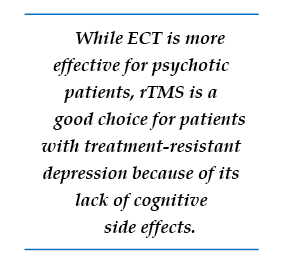RTMS Versus ECT
 We’ve been posting about repeated transcranial magnetic stimulation (rTMS), a treatment in which a magnetic field is applied to a patient’s head, where it is able to affect tissue 2-3 centimeters into the brain.
We’ve been posting about repeated transcranial magnetic stimulation (rTMS), a treatment in which a magnetic field is applied to a patient’s head, where it is able to affect tissue 2-3 centimeters into the brain.
In randomized, controlled, head to head comparisons of electroconvulsive therapy (ECT) and repeated transcranial magnetic stimulation (rTMS), ECT often proves superior, particularly for a more severe psychotic or medically compromised patient. Nonetheless, for a more routine patient with non-psychotic depression, multiple studies have shown approximate equivalence of rTMS and ECT, while rTMS may have a superior benefit-to-risk ratio because it brings less risk of cognitive dysfunction. Thus, given almost equivalent efficacy for some subgroups of depressed patients, and a clear advantage for rTMS in terms of lack of cognitive side effects, this editor/clinician would recommend a course of rTMS prior to a series of ECT for the subgroup of non-emergency treatment-resistant depressed patients.
However, for highly treatment-refractory, severe, and particularly psychotic depression, few treatments appear to approach the efficacy and rapid response onset of electroconvulsive therapy (ECT). ECT as given in the modern era involves anesthesia and muscle paralysis while the patient is mechanically ventilated in order to prevent any damage from muscle contractions during the seizure.
Minimizing risks of ECT
Bilateral ECT specifically has been associated with some decrements in autobiographical memory that can persist for six months or longer following the end of an ECT treatment series, as shown by Sackeim and colleagues in their series of patients studied in the region of New York City.
In contrast, right unilateral brief pulse high intensity ECT appears not to be associated with such decrements in autobiographical memory, and if patients should elect for a course of ECT, the right unilateral brief pulse variety may be safest. If the right unilateral approach ultimately proves ineffective, a patient can always switch to the bilateral approach if necessary.
However, given the demonstrated efficacy of rTMS for a substantial group of patients who have not been responsive to drugs, a course of rTMS might be considered prior to ECT, especially when there are no emergency indications such as high risk of suicide, psychosis, or life-threatening medical comorbidities and complications.
Longer term preventive approaches needed
A potential downside of rTMS and ECT is that once the acute treatment series has ended, the patient needs prophylactic drug treatment. This is particularly the case among patients with recurrent and rapid cycling courses of unipolar or bipolar disorder. In these instances, if possible, it may be useful to explore complex combinations of psychopharmacological approaches in an attempt to find a regimen that achieves long-term mood stability rather than immediately resorting to a course of rTMS or ECT, where the long-term treatment follow-up would have to be newly devised. Both rTMS and ECT can be tapered in order to shift treatment to long-term medication-based prophylaxis, but the precise modes for achieving long-term preventive strategies with either treatment approach have not been explored systematically.
Comments
Leave a Reply

